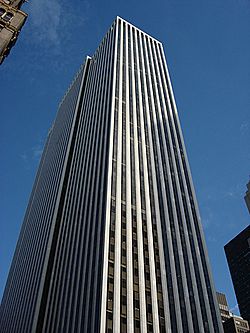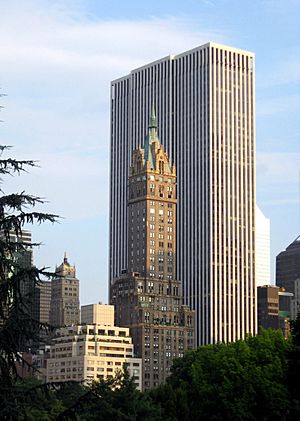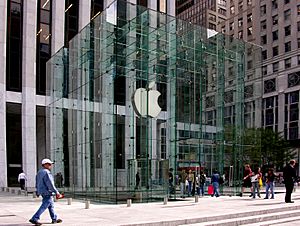General Motors Building (Manhattan) facts for kids
Quick facts for kids General Motors Building |
|
|---|---|

The building as seen from 59th Street
|
|
| General information | |
| Status | Complete |
| Type | Offices, retail |
| Architectural style | International Style |
| Location | 767 5th Ave New York, NY 10153 |
| Coordinates | 40°45′50″N 73°58′21″W / 40.76389°N 73.97250°W |
| Construction started | 1964 |
| Completed | 1968 |
| Owner | Boston Properties |
| Height | |
| Roof | 705 ft (215 m) |
| Technical details | |
| Floor count | 50 |
| Floor area | 1,637,363 sq ft (152,116.0 m2) |
| Lifts/elevators | 35 |
| Design and construction | |
| Architect | Edward Durell Stone & Associates Emery Roth & Sons |
| Developer | Cecilia Benattar |
| Engineer | The Office of James Ruderman |
The General Motors Building is a very tall office building in Manhattan, New York City. It has 50 stories and stands 705 ft (215 m) high. You can find it at 767 Fifth Avenue.
This building is special because it takes up an entire city block. It is located between Fifth Avenue and Madison Avenue, and between 59th and 58th Streets. From the building, you can see amazing views of Central Park.
The General Motors Building was designed in the International Style. This was done by Edward Durell Stone & Associates and Emery Roth & Sons. It was finished in 1968. It is one of the tallest buildings in New York.
Today, the building is owned by a group of companies. These include Boston Properties, Zhang Xin, and the Safra banking family. It is known as one of New York's most famous and expensive office buildings.
Contents
History of the Building

The General Motors Building was built by Cecilia Benattar. She was the head of a large British company called London Merchant Securities PLC.
General Motors Owns the Building
The building first opened its doors in September 1968. When it opened, about 3,027 workers from General Motors (GM) worked there. They used about half of the building's space.
In 1981, General Motors moved many of its workers to Detroit. This meant they used much less space in the building. In April 1981, GM decided to sell the building.
Instead of selling it right away, GM made a deal in 1982. They sold an option to a company called Corporate Property Investors. This option allowed Corporate Property Investors to buy the building in 1991. This was a very big deal for an office building in New York City at the time. Corporate Property Investors also became the managers of the building.
Corporate Property Investors Takes Over
In 1990, Corporate Property Investors started a big renovation of the building. They spent $7.5 million to fix windows and replace many of the outside marble slabs. In February 1991, they used their option to buy the building from General Motors.
By 1995, General Motors was thinking about leaving New York City. But after their employees asked them to stay, and with some tax help from the city, GM signed a smaller lease. They kept a much smaller office space in the building. This also meant the GM car showroom on the first floor closed. It had been there since the building opened.
Donald Trump's Time as Owner
In 1998, Conseco and Donald Trump bought the General Motors Building. They paid $878 million for it. Donald Trump made some changes to the building. He filled in a sunken area outside that many people didn't use. He also put his name in large gold letters on the building.
From 1999 to 2012, the building was home to CBS's TV show The Early Show.
Harry Macklowe's Ownership
In 2003, Trump and his partners sold the building for $1.4 billion. This was the highest price ever paid for an office building in North America at that time. The new owner was the Macklowe Organization.
After buying it, Macklowe spent $150 million to update the building. This included creating the space for the famous Apple Store and new retail shops.
Boston Properties Becomes Owner
In 2008, the Macklowe Organization decided to sell the GM Building. It was sold for about $2.8 billion to a group of companies. This group included Boston Properties, Goldman Sachs Real Estate Opportunities Fund, and Meraas Capital. This was the biggest single building sale in 2008.
In 2017, the building was valued at $4.8 billion. This makes it one of the most valuable office buildings in New York City.
Building Design
The design of the General Motors Building was finished in the same year the 1964 New York World's Fair opened. Construction started in 1965 and was finished in 1968. The outside of the building is made of "glistening white Georgia marble" and large glass panels. This gives it a very tall and smooth look.
The building is known for its important tenants and location. It has also been home to some famous stores. Until 2015, the ground floor had FAO Schwarz's flagship toy store. This store was even featured in the movie Big.
The building also has the flagship Apple Store. Its entrance is a large 32 ft (9.8 m) glass cube. This cube looks a bit like the Louvre Pyramid in Paris. You go down into the store using a glass elevator or a spiral staircase. Apple and the firm of Bohlin Cywinski Jackson designed this unique entrance.
Tenants
Many different companies have offices in the General Motors Building. Some of them include:
- Banco Itaú Unibanco
- ContiGroup Companies
- Estée Lauder Companies
- Icahn Enterprises
- J.C. Flowers & Co.
- Perella Weinberg Partners
- Weil, Gotshal & Manges
- York Capital Management
Images for kids
See also
 In Spanish: General Motors Building para niños
In Spanish: General Motors Building para niños



